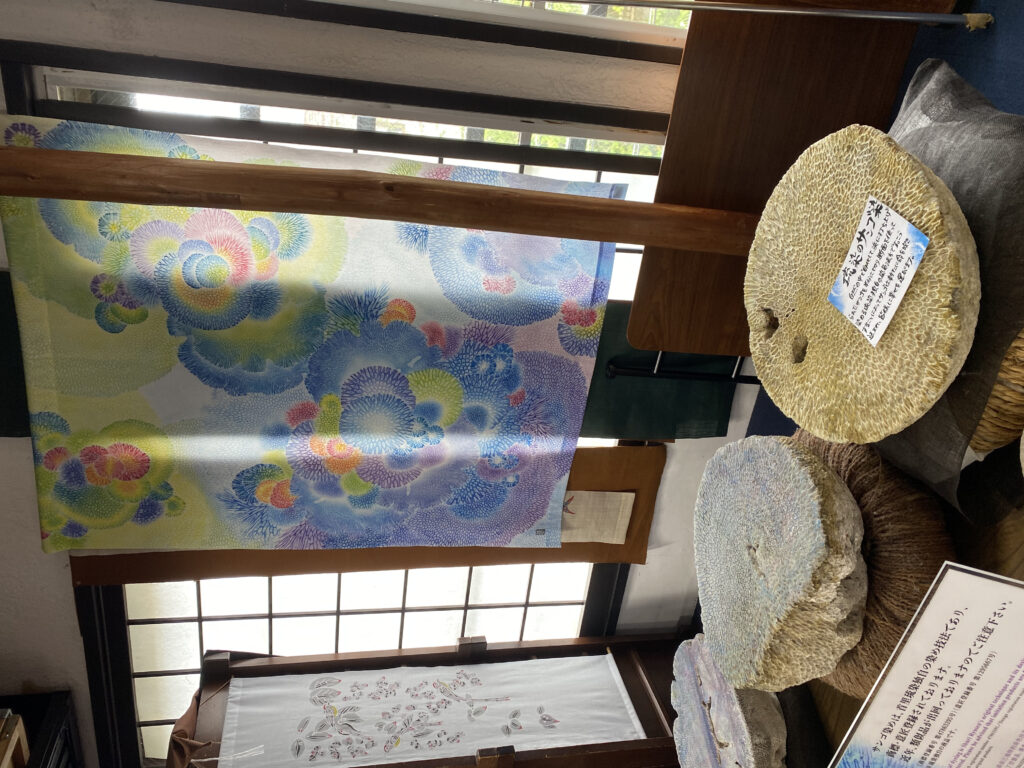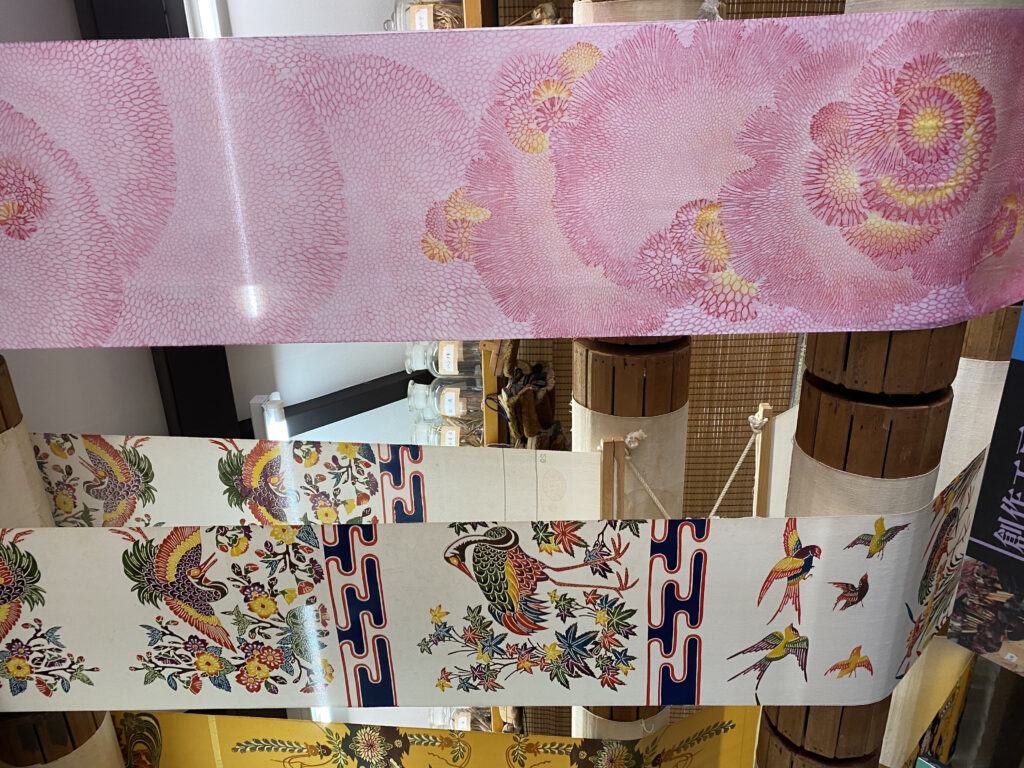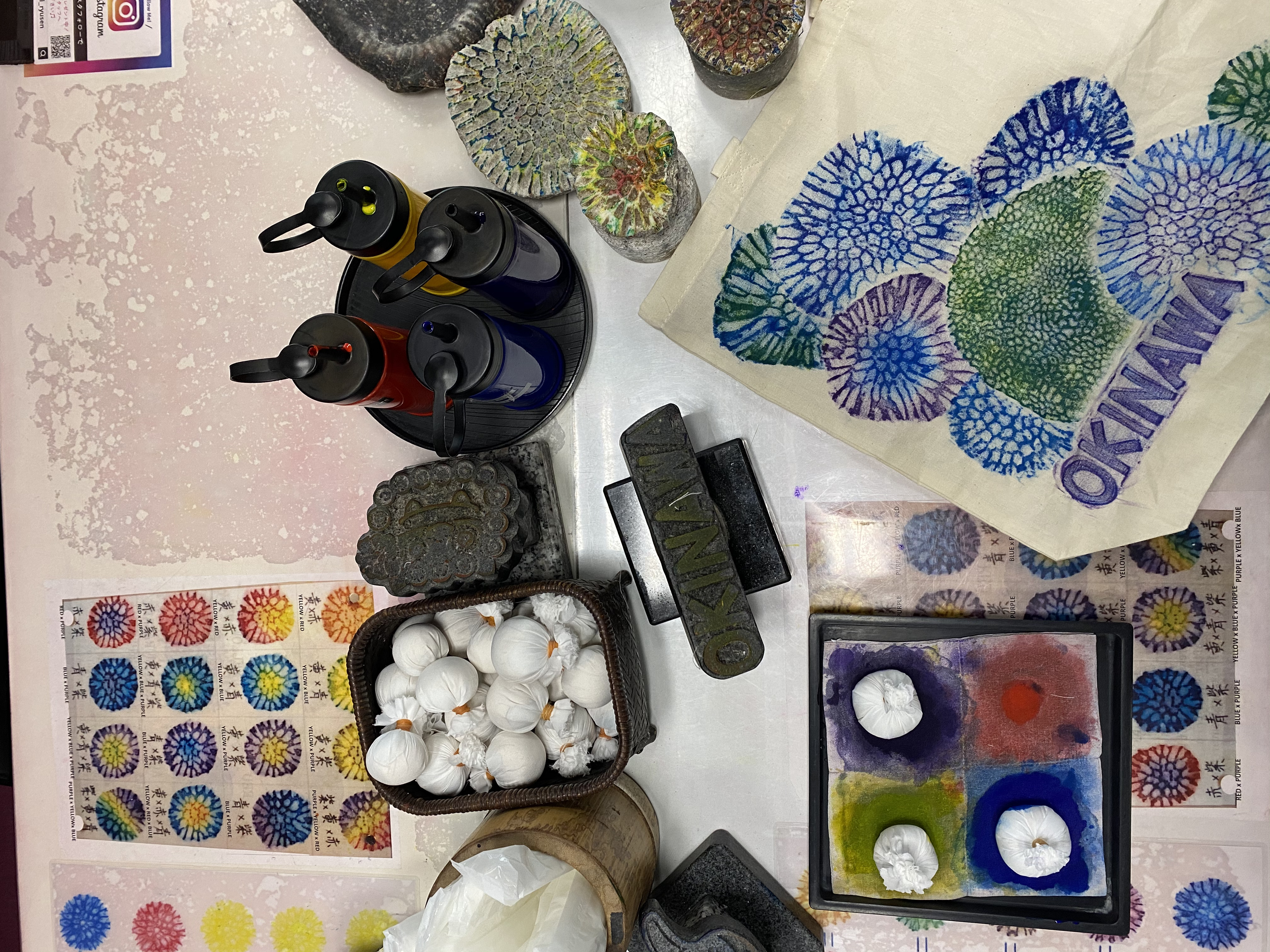This article originally appeared in the May 2023 issue of CONNECT.
Sophie McCarthy (Hyogo)
Okinawa is a world class travel destination with a dizzying amount of activities to do and things to see. Between the luxurious beach resorts and campy Americana shops, it is easy to lose sight of what is actually considered “Okinawan” culture. However, a traveler only has to stroll through the small, windy backstreets of Naha to catch a glimpse of the Ryukyuan customs that have long persevered in the face of much adversity. The culture of Okinawa is a unique blend of native, Japanese, and other Asian influences, which is fully represented in the artform of bingata.
Bingata (Okinawan: 紅型, literally “red style”) is a stenciled, resist dyeing technique originating in Okinawa from about the 14th century. Put simply, a resist dyeing technique involves using a stencil pattern covered in wax or paste. The stencil is placed on the fabric for the areas not intended for dyeing. Then the dye is applied, starting from lighter colors to darker colors. After letting the dye set for a while, the fabric is washed to remove the wax residue.
The vibrant and graphic colors and motifs (usually fish, birds, flowers, and fauna) quintessentially encapsulate the spirit and atmosphere of Japan’s southernmost prefecture.
 While originally created for and worn by royalty and nobility, today bingata can be enjoyed by everyone, especiallyOkinawans during traditional Ryukyuan festivals and performances. Part of the historical luxury of bingata came from the rarity of the dyes. Traditionally and mostly still true today, bingata uses natural pigments such as indigo and fukugi tree dye. In olden times, dye colors were classified according to rank, age, and gender. The highest-ranking color was yellow, which was exclusively reserved for royalty and aristocrats. The lower classes only had access to much simpler design patterns and colors, such as indigo and black. The vibrant and graphic colors and motifs (usually fish, birds, flowers, and fauna) quintessentially encapsulate the spirit and atmosphere of Japan’s southernmost prefecture. For a first hand viewing experience, some historical Bingata kimono are displayed at the Naha City Museum of History. As with many aspects of Okinawan culture and Ryukyuan culture before that, influences from China, India, and Southeast Asia are seen within the style of bingata.
While originally created for and worn by royalty and nobility, today bingata can be enjoyed by everyone, especiallyOkinawans during traditional Ryukyuan festivals and performances. Part of the historical luxury of bingata came from the rarity of the dyes. Traditionally and mostly still true today, bingata uses natural pigments such as indigo and fukugi tree dye. In olden times, dye colors were classified according to rank, age, and gender. The highest-ranking color was yellow, which was exclusively reserved for royalty and aristocrats. The lower classes only had access to much simpler design patterns and colors, such as indigo and black. The vibrant and graphic colors and motifs (usually fish, birds, flowers, and fauna) quintessentially encapsulate the spirit and atmosphere of Japan’s southernmost prefecture. For a first hand viewing experience, some historical Bingata kimono are displayed at the Naha City Museum of History. As with many aspects of Okinawan culture and Ryukyuan culture before that, influences from China, India, and Southeast Asia are seen within the style of bingata.
This intangible cultural asset almost completely disappeared after the Battle of Okinawa in 1945. During this infamous battle, countless bingata shops were destroyed, and many of the original stencils that had been passed down through generations were now gone. Fortunately, the craft was preserved thanks to the dedicated work of a few, such as Eiki Shiroma. During the Ryukyu period up and up to World War II, there were three major families running the bingata industry: Chinen, Shiroma, and Takushi. Eiki Shiroma, who was a bingata artist carrying out his family’s legacy before the war, saw the dire situation the craft was in—how it could be lost forever if something was not done. He traveled to mainland Japan in search of original stencils that had been accrued by Japanese artists, collectors, and soldiers. Thanks to his and others’ diligent efforts, not only has bingata survived extinction, but it has thrived and taken on new variations in what is now considered the revival period of bingata.
 The founder of Shuri Ryusen bingata studio, Koto Yamaoka, also played a key role in reimagining the Okinawan custom through research into new plant paints, quality improvement, and innovative stencil methods and techniques. One such technique is the practice of using coral fossils. The idea formed entirely by happenstance. One day, Yamaoka was walking along the beach and found a dead piece of coral. Coral being locally associated with wishes for the prosperity of descendants, longevity, and a happy family, Yamaoka decided to use the coral as a stamp pattern for bingata. Fast forward to today, Shuri Ryusen in Naha offers one of the most interesting experiences for tourists visiting Okinawa. For only 3,300 yen, a visitor can create their own original coral pattern design in the Bingata style on a tote bag, T-shirt, or wrapping cloth. Since coral harvesting is normally illegal and Shuri Ryusen is the only bingata shop that holds a special license and trademark for this pattern making method, the hour-long workshop is truly a once in a lifetime experience worth every yen. After completing the DIY craft, visitors can also take a tour through the shop’s beautiful studio space, displaying the intricate patterns and fabrics created there. At Shuri Ryusen, guests get to leave with not only a beautiful item they have created. They also get the deep honor of knowing that they played a small part in keeping this ancient artform alive.
The founder of Shuri Ryusen bingata studio, Koto Yamaoka, also played a key role in reimagining the Okinawan custom through research into new plant paints, quality improvement, and innovative stencil methods and techniques. One such technique is the practice of using coral fossils. The idea formed entirely by happenstance. One day, Yamaoka was walking along the beach and found a dead piece of coral. Coral being locally associated with wishes for the prosperity of descendants, longevity, and a happy family, Yamaoka decided to use the coral as a stamp pattern for bingata. Fast forward to today, Shuri Ryusen in Naha offers one of the most interesting experiences for tourists visiting Okinawa. For only 3,300 yen, a visitor can create their own original coral pattern design in the Bingata style on a tote bag, T-shirt, or wrapping cloth. Since coral harvesting is normally illegal and Shuri Ryusen is the only bingata shop that holds a special license and trademark for this pattern making method, the hour-long workshop is truly a once in a lifetime experience worth every yen. After completing the DIY craft, visitors can also take a tour through the shop’s beautiful studio space, displaying the intricate patterns and fabrics created there. At Shuri Ryusen, guests get to leave with not only a beautiful item they have created. They also get the deep honor of knowing that they played a small part in keeping this ancient artform alive.
Thanks to his and others’ diligent efforts, not only has bingata survived extinction, but it has thrived and taken on new variations in what is now considered the revival period of bingata.
Benjamin Franklin once said “Out of adversity comes opportunity” and it is hard to ignore the immense amount of hardship that has spattered the Ryukyuan Kingdom and Okinawa’s history. However, through this turmoil, a resilient and dynamic culture of art, music, and language marches on and should be recognized and appreciated by all those who visit.
Sophie McCarthy was a JET for four years (2018-2022) in Kobe, Hyogo, and now lives in Tokyo. In her free time, she enjoys reading classic literature, visiting coffee shops, and practicing film photography. Check out her photos on Instagram: @filmbysophie
Sources
Art Island Okinawa
Image Credits
Sophie McCarthy




